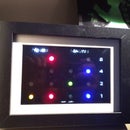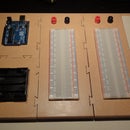Introduction: Arduino RGB LED Strip Controller
I was curious about using RGB LED Strip, so I got one and decided to do a little controller to see what I can do with it... so here it is.
If you have any questions, comments, constructive criticism... don't hesitate to write :)
If you like my build, please like the video on YouTube and subscribe, it would be nice :)
Step 1: Components
- Arduino UNO (or probably any other Arduino)
- A breadboard
- RGB LED strip
- Hook-up wires (black, red, green, yellow)
- 9 volt battery
- 9 volt snap batter connector
- 3 Potentiometers (10k or others probably work too)
- 3 Transistors (I have BC547B, but others would do the job just fine, or even Mosfets)
Step 2: The Schematic
This is what the circuit looks like... I used "123D Circuits" by Autodesk.
They don't have an LED Strip component, so I replaced it with the RGB LED here... but never connect an LED to a 9V battery without resistance, you will blow the LED.
Now let's build it
Step 3: Voltage and Ground
Connect the voltage and the ground from your Arduino to the tracks of your breadboard.
Step 4: Potentiometers
Install the potentiometers on your breadboard
Step 5: Inputs
Connect the middle pin of you potentiometers to the analog pins A0, A1 and A2 of your Arduino, this will send a different voltage to the pins of the Arduino depending of the position of the potentiometer. Check the specs of your potentionmeters to know which pin is which.
Step 6: Potentiometers Voltages and Grounds
Connect the voltage and grounds to the potentiometers. Check the specs of your potentionmeters to know which pin is which.
Step 7: Transistors
Install the transistors on your breadboard. Google the model number of your transistor to know the pin configuration. Here you can find the documentation of the transistors I used, the BC547B, but don't rely on this for your transistors, because the pin configuration isn't standard.
Step 8: Outputs
Connect the "base" pin of your transistor to digital PWM pins on your Arduino, I used pins 3, 5 and 6. Those will send the desired current to the transistors to light up the amount of each colour (red, green and blue) separately.
Step 9: Transistors Grounds
Connect the "emitter" pins of your transistors to the ground. Again check the documentation of the transistor your are using to know the correct pin configuration.
Step 10: The Battery and the Strip
Finally, connect the "collector" pin of your transistors to the LED strip,check your strip to know which pin is which colour. Then connect your battery snap wires, black to the ground and red to the anode (positive) pins of the strip. Now we just need to program the Arduino and try it.
Step 11: The Code
This is the code to be able to run the controller. It's very basic, taking the value of the resistance coming from the potentiometers, limiting it and sending it to the LED strip via the transistors.
int const rPotPin = A2;
int const gPotPin = A1;
int const bPotPin = A0;
int const rOutPin = 3;
int const gOutPin = 5;
int const bOutPin = 6;
int rVal;
int gVal;
int bVal;
void setup()
{
pinMode(rOutPin, OUTPUT);
pinMode(gOutPin, OUTPUT);
pinMode(bOutPin, OUTPUT);
}
void loop()
{
rVal = analogRead(rPotPin) / 4;
gVal = analogRead(gPotPin) / 4;
bVal = analogRead(bPotPin) / 4;
analogWrite(rOutPin, rVal);
analogWrite(gOutPin, gVal);
analogWrite(bOutPin, bVal);
}
Step 12: The Final Product
Here you can see some of the colours you can create with different potentiometer positions :)
Step 13: Here's How to Build It and What It Does
If you like my build, please like the video on YouTube and subscribe, it would be nice :)





